 |
||
|
||
| ||
TABLE OF CONTENTS
As is well known, NVIDIA launched GeForce 7800GTX 512MB (it should have been actually named 7800 Ultra) to spite RADEON X1800 XT from ATI. But to the regret of customers as well as a number of trade organizations, the title remained the same and confuses people. We've already heard complaints that users are not informed about the increased frequencies of this model. They think that this model is just equipped with more memory and they all don't want to pay through their nose for the new video card. Unfortunately, there are currently problems with availability of these cards. Despite the uber-high prices, rarely seen in even unique accelerators, the cards are instantly swept from the shelves. I hope this problem will be solved in the shortest time, or RADEON X1800 XT has all the chances to become a bestseller among the most powerful gaming accelerators (the average price for it in mid October went down to 630 USD). But the 7800 GTX 512MB has one obvious advantage: rich users may purchase two cards and install them in SLI mode, which is not available to potential and real owners of X1800 XT cards (master cards are not yet on sale). We are going to review separate products as well as their operation in SLI mode. It will be the most powerful 3D solution in the gaming sector! Getting back to GeForce 7800 GTX 512MB, it should be noted that a number of companies did not confine themselves to the increased GTX potential, and started selecting samples that could work at still higher frequencies. In particular, Gainward launched such a product in the Golden Sample series. This accelerator will be reviewed today. GeForce 7800 GT was also included into the Golden Sample series. This card has been participating in our 3Digest for a long time. But unfortunately, it has appeared in our review only now. Both products are from Gainward. Oh, it's so difficult to write univocally about this company! It started well on the Russian market, its products were remarkable. If you had asked me in times of GeForce3, which company offered better 2D quality - Gainward or Leadtek, I would have found difficulty in replying or even would have preferred Gainward. Cards from this company were notable for their immaculate quality! Best selling companies ASUS or Gigabyte (MSI) would sometimes slow down, their products would have a lot of defective samples or would be not interesting. That is they were developing as a sine curve. But Gainward was steadily growing. But when the company employed the manager who had ruined Hercules and offered the idea to overclock cards and create the Golden Sample series, the company got into rugged times. That very manager also raised high the prices for Gainward products, which resulted in the drop of demand and interest to these products. That was especially noticeable on the Russian market. Gainward's popularity even went into a spin after 2002. Products from this company were gloomily and slowly falling into oblivion despite multiple visits and moves from the company management. Besides, the local representative office did nothing to promote sales, they offered no samples. So, the company was actually driven out of the market. Gainward was expectedly heading towards its destruction (on the grounds of the above said). By the way, renewed Hercules had left the market of video cards for the same reason (untalented marketing). This notorious Golden Sample series brought grand losses (the Hercules situation repeated itself). As a result, this business was sold and Gainward got the new management. Thank God, that manager was fired. (He now works in eVGA, and we already gamble on how long this company will survive). The new management changed the policy, updated the representative office in Moscow, and these poor people are now responsible for delivering products to our consumers in the slush of our market. We are happy to note that all these traverses, toils and trouble have not affected the most important - the quality of products, Gainward is still up to the mark. In other respects - we'll see how this company will do in Russia. And the last but not the least! For the first time a review of a video card will also dwell on a PSU. Of course, we shall examine it only from the consumer point of view, the sterling review by the book will be published in a new year. Why did I include it into the article? That's because it was very interesting to test SLI GeForce 7800 GTX 512MB together with a new SLI Ready PSU from Hiper. Besides, the PSU itself is unusual. So, let's return to video cards.
Video card
In both cases the company obviously just bought reference cards from NVIDIA, tested them, selected those that can be overclocked, applied its stickers, and packed them into its boxes. Unfortunately, the company has nothing to do with manufacturing these cards. However, this company is not alone in this respect. Up to now, only ASUS manufactures 7800 GT cards. All the other NVIDIA partners prefer to buy ready cards, instead of chips and memory modules and manufacture cards on their own. Of course, GeForce 7800 GTX 512MB cards will always be of the reference design. There are few cards anyway, no point in wasting time, efforts, and money on manufacturing such monsters on their own. Both products are equipped with two DVI jacks (of course, Dual-Link), they support VIVO.
That's how the most powerful tandem with two GeForce 7800 GTX 512MB cards in SLI mode looks like:
Even its exterior is impressive. :)
Indeed, it's tiresome to describe reference cards over and over again. To my regret, NVIDIA partners do not stir a finger to introduce anything of their own.
Here is the bundle. It's identical in both cards. There is actually nothing new, a standard bundle of accessories (cables and discs with software and PowerDVD). There are no games in the bundle.
The box is traditionally large. The only difference is a sticker again. :( The company still cannot manufacture separate boxes with its own design, even though weaker companies can do it. Gainward has been reproached with it many times (by the way, it's the heritage of the same manager), but things aren't moving.
Power Supply UnitLet me introduce the company first: HIPER is a trademark of High Performance Group, formed in 2000 in Great Britain (Milton Keynes). It has its own manufacturing facilities in China (Guang Dong). It has several subsidiaries, one of them in Moscow. The company manufactures a wide range of products: Media centers, power supply units, fans, modding equipment, etc.
Our lab got hold of the latest product among power supply units: HPU-4R580. Here are its specifications:  Thus, the PSU outputs 580 Watts (peak loads exceed 600 Watts). Most importantly, the device is certified as SLI Ready, it manages to provide necessary output for two most powerful accelerators (we checked it up when testing a couple of GeForce 7800 GTX 512MB cards). Detailed load test results will be published in a separate review of this power supply unit.
When I saw some plastic box, I didn't expect what was inside it.
Yep, the designers did a great job: we have a bonus - all-purpose box for storing any stuff, there are even sections for small items.
PSU bundle:
The second striking thing: the PSU is based on the modular principle. That is there are no redundant cables! All cables, except for the main one, can be connected when necessary.
The PSU has two fans: a large fan that sucks the air in from a PC case and a small fan - to drive the hot air out.
The main power connector is composite: 20+4 pins.
Both fans have red illumination:
In conclusion of this PSU review I want to repeat that this product qualifies for being SLI compatible. It did not fail any test. It's convenient to mount (you can install only what cables you need). The bundle contains everything necessary. User's guide will help you, if you don't understand anything.
Let's return to our video card tests.
Installation and DriversTestbed configurations:
I have already noted that the cooling system in the GTX 512Mb is very efficient, so the core temperature under maximum load at standard frequencies did not reach even 80°C (note that the standard frequencies in GS cards are higher than in the reference card). The peak rotational speed (100%) is 2000 rpm. And it's still noiseless.

Almost nothing changed in SLI mode, only the fan would speed up to 100% rpm more often.
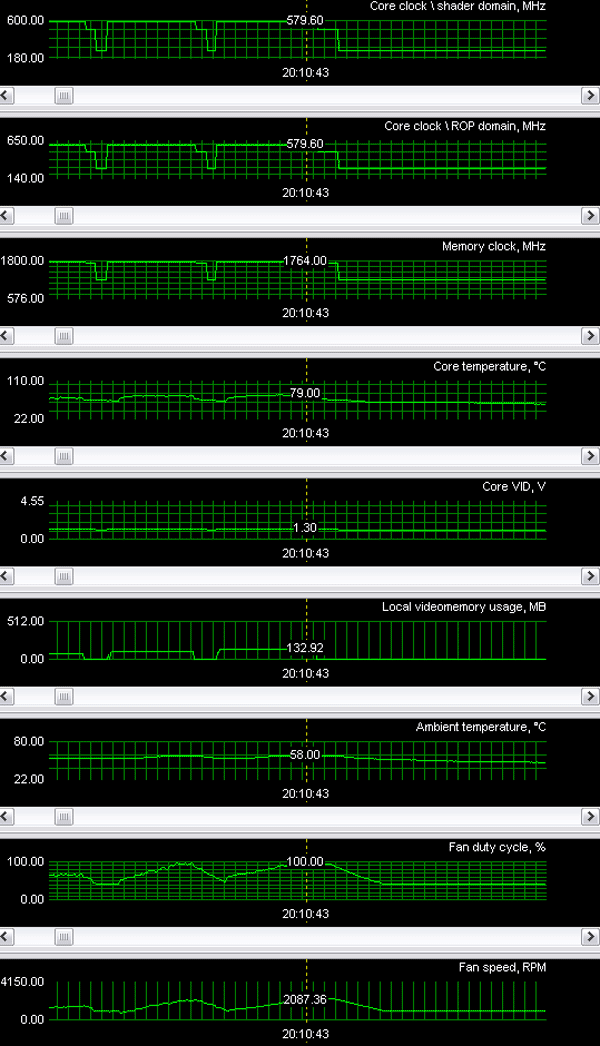
Test results: performance comparisonWe used the following test applications:
Gainward PowerPack GeForce 7800GTX 512MB Golden Sample Test ResultsGame tests that heavily load vertex shaders, mixed pixel shaders 1.1 and 2.0, active multitexturing.FarCry, Research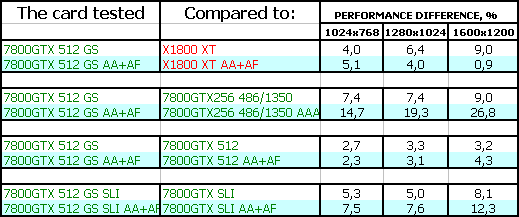
Game tests that heavily load vertex shaders, pixel shaders 2.0, active multitexturing.F.E.A.R. v.1.01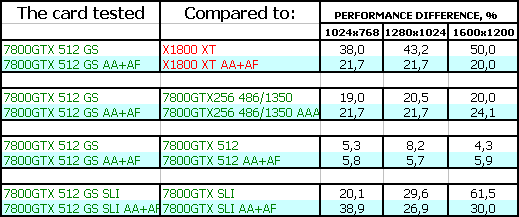
Splinter Cell Chaos Theory
Call Of Duty 2 DEMO Half-Life2: ixbt01 demo

Game tests that heavily load pixel pipelines with texturing, active operations of the stencil buffer and shader unitsDOOM III High mode Chronicles of Riddick, demo 44
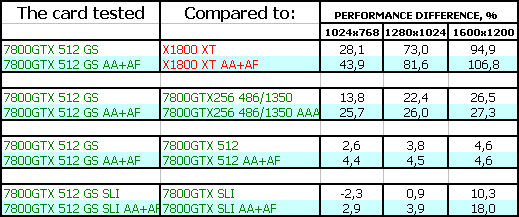
Synthetic tests that heavily load shader units3DMark05: MARKS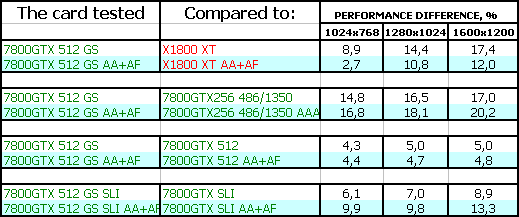 I guess there is no point in commenting each test, everything is crystal clear: Gainward PowerPack GeForce 7800GTX 512MB Golden Sample is currently the most powerful gaming accelerator (among single chip models). The advantage over competitors is impressive. Moreover, it's high time to use such video cards in heavier modes with AA 8x and sterling anisotropy (HQ mode). Performance is very high even in graphics-intensive applications. SLI mode with these cards demonstrates sky-high results. Unfortunately, all super heavy modes in ATI and NVIDIA differ much in quality and implementation. That's why it's impossible to compare performance in these modes. It would have been incorrect. So poor testers are left only with AA4x+AF16x, which cannot load such powerful cards even at 1600x1200. Perhaps we should increase test resolutions. But on the other hand, it's not relevant for Russian users so far.
Gainward PowerPack GeForce 7800GT 256MB Golden Sample Test Results
This card has been participating in our comparison tests for a long time and it fairs very well. Priced at the level of X1800 XL, this product outperforms the competitor in the majority of tests and demonstrates excellent price-performance-features ratio. It should be said that the new Gainward pricing policy puts the GS series on the level with other competitors, operating at the standard frequencies, which differs the GS models from the other models. Unfortunately, there are few such cards on our market so far (for objective reasons). ConclusionsGainward PowerPack GeForce 7800GTX 512MB Golden Sample is currently the most powerful and the most expensive gaming accelerator. The latest information on prices is shocking (such cards are sold for 850 USD in Moscow retail). But the demand is still tremendous, the cards disappear from the shelves in mere hours! Dealers (distributors) would be glad to import more of them, but the deficit of these cards makes itself felt, it's hard to find them in stores. I cannot really tell whether this card is worth $850. The price is obviously too high, it's dictated by the deficit and the backlog of demand. I guess it makes sense to pay attention to RADEON X1800 XT, which is much cheaper, though one step lower! So, it's up to you to decide. But all this does not belittle manufacturer's pride for its product, which is indeed the most powerful accelerator. More powerful video cards just don't exist. What concerns operating stability, it's up to the mark, despite the increased frequencies. An excellent cooling system, a quiet cooler. Excellent 2D quality. Gainward PowerPack GeForce 7800GT 256MB Golden Sample is a mid product from the Hi-End sector, if we may say so. This card is a step lower than the previous card, but its price is nearly twice as low. It stands out among its competitors with its increased frequencies and offers the best performance for its price. Operating stability is also excellent, 2D quality is up to the mark.
PSU Hiper Type-R HPU-4R580 is a very interesting product. I have already written everything I could squeeze into a short review. The product obviously has a lot of advantages: guaranteed SLI support on the level of top video accelerators, modularity, high power, excellent bundle.
You can find more detailed comparisons of various video cards in our 3Digest.
We have a rule not to award products, which are no different from the reference design. But in this case editors' opinions were divided. But Gainward offered the most powerful accelerator and spent some effort on testing and selecting samples that could operate at increased frequencies! That's why we made an exception and Gainward PowerPack GeForce 7800GTX 512MB Golden Sample PCI-E got the Original Design award (December).
PSU Hiper Type-R HPU-4R580 has got the same award.

Theoretical materials and reviews of video cards, which concern functional properties of the GPU ATI RADEON X1800 (R520)/X1600 (RV530)/X1300 (RV515) and NVIDIA GeForce 6800 (NV40/45)/7800 (G70)/6600 (NV43)
Write a comment below. No registration needed!
|
Platform · Video · Multimedia · Mobile · Other || About us & Privacy policy · Twitter · Facebook Copyright © Byrds Research & Publishing, Ltd., 1997–2011. All rights reserved. | |||||||||||||||||||||||||||||||||||||||||||||||||||||||||||||||||||||||||